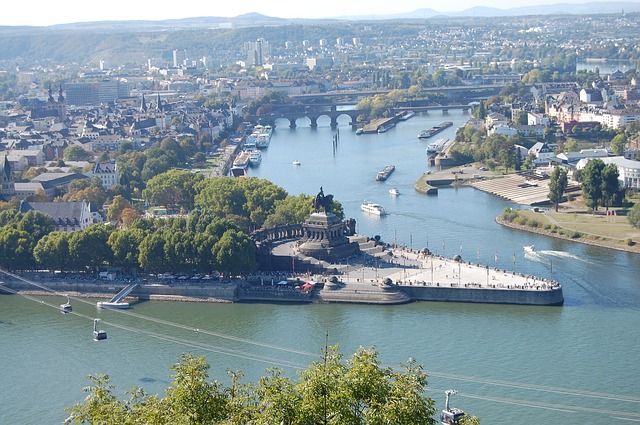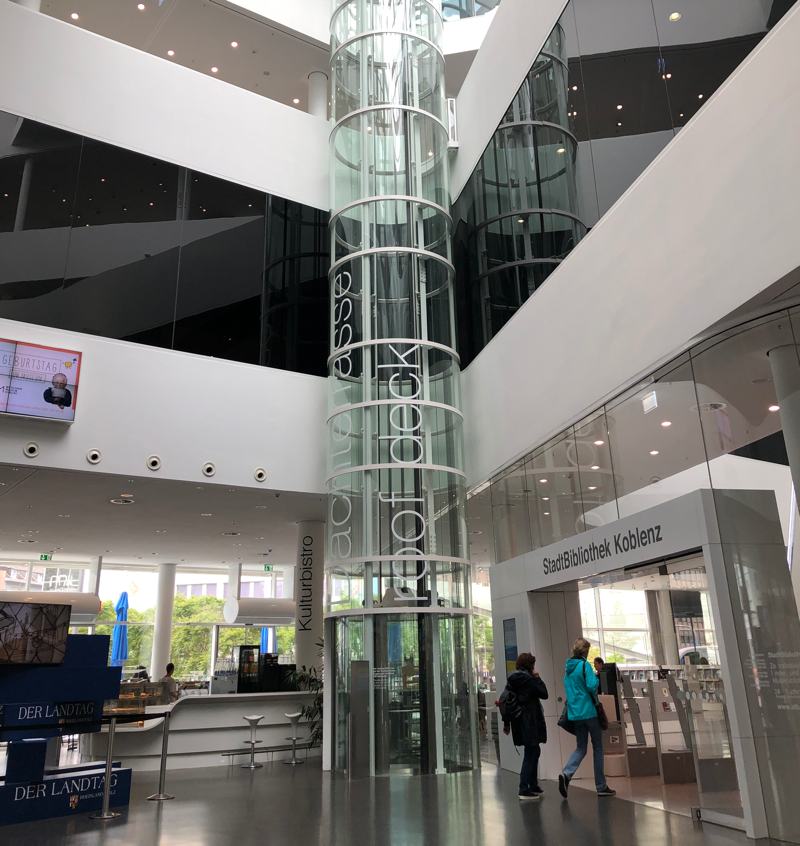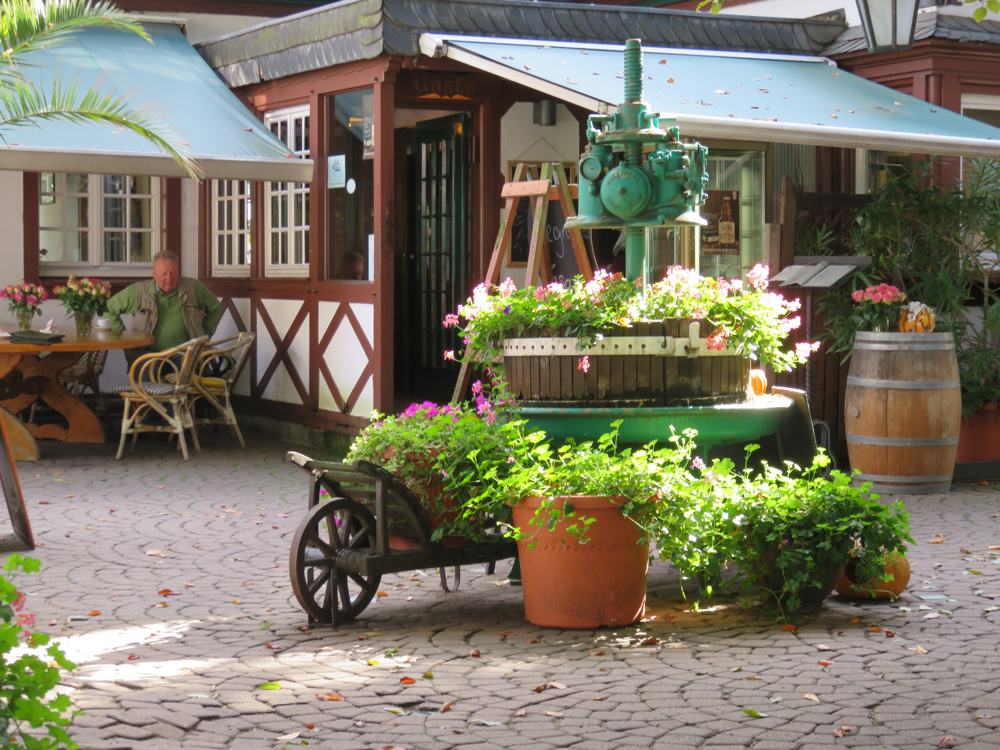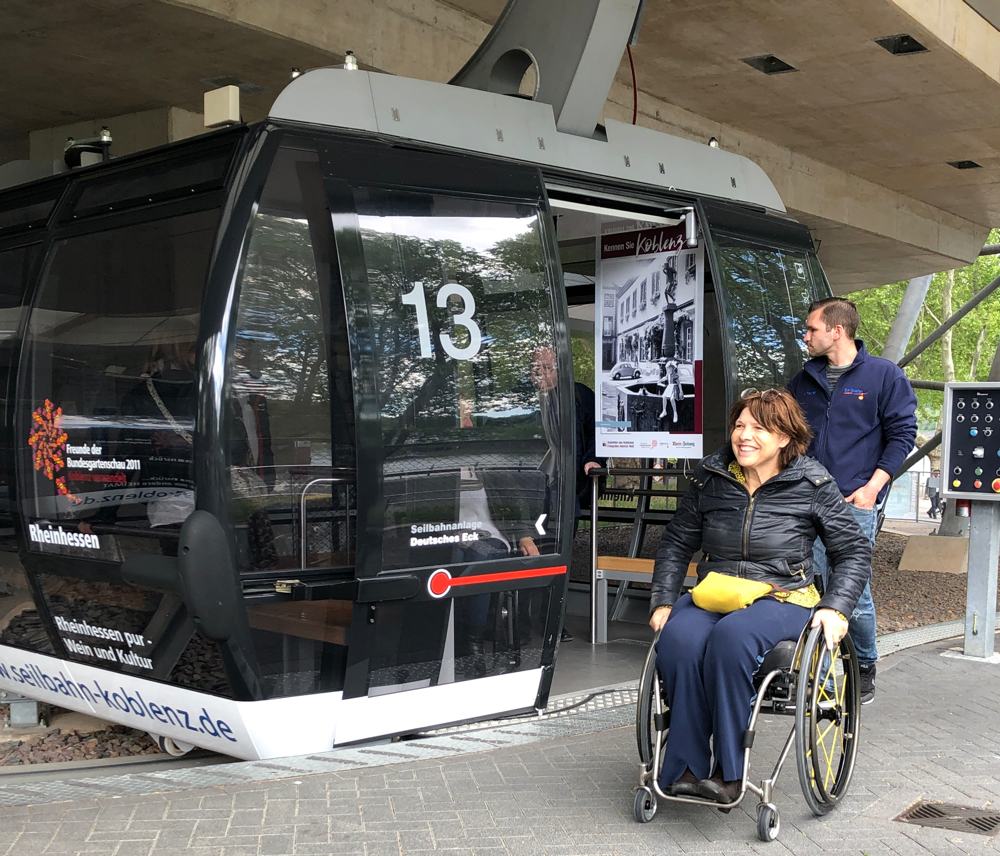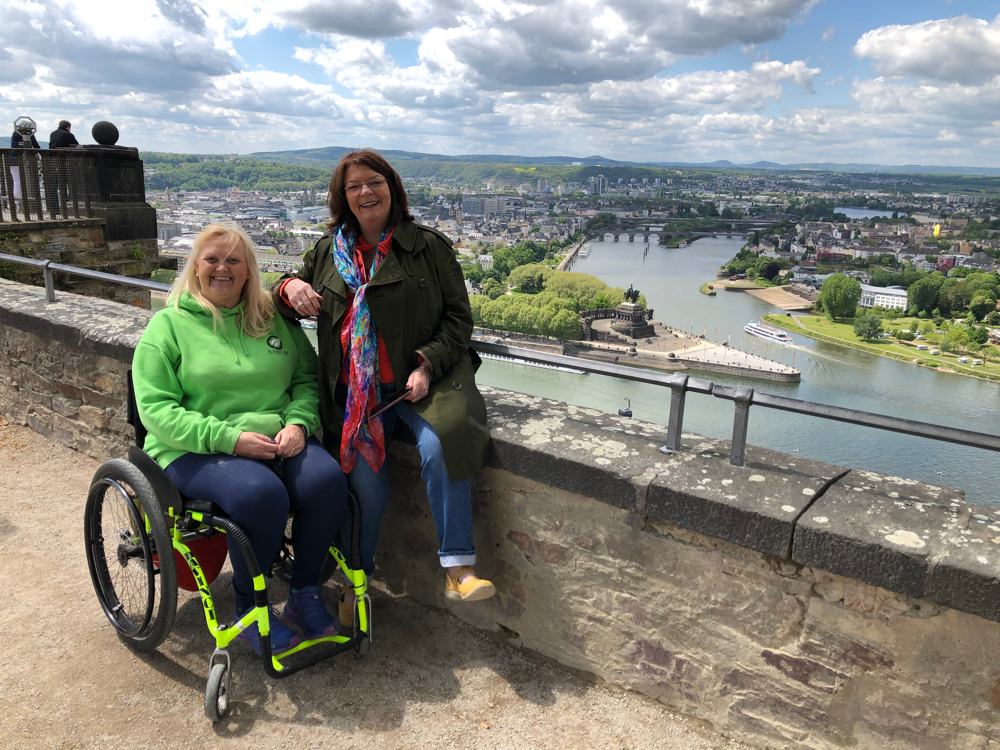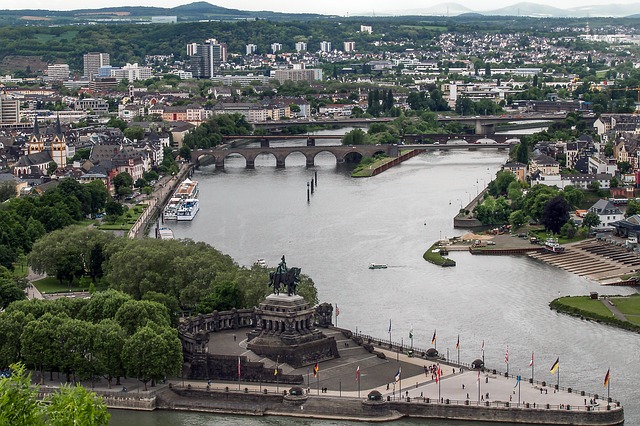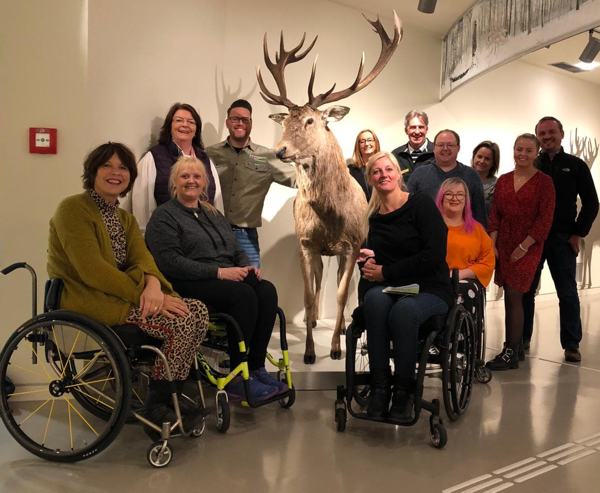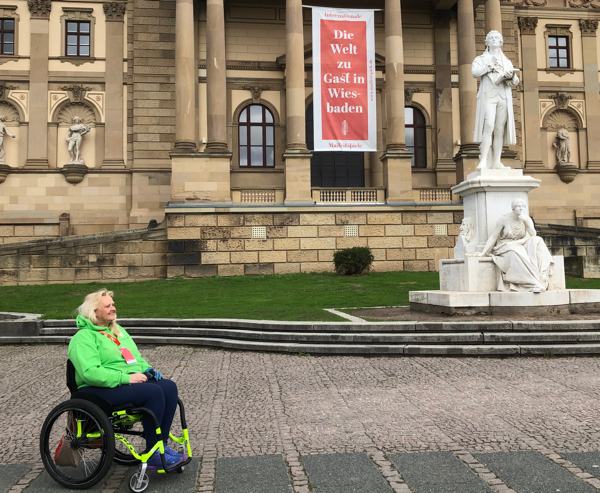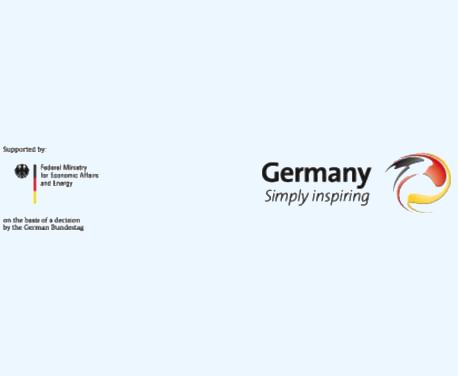Koblenz is a wonderful Roman settlement in central Germany. It is a city that is easily accessible plane, with the three main airports of Frankfurt, Bonn and Dusseldorf being just over an hour away. There is a railway station in the centre of this world heritage UNESCO site and regular trains run from the station in the centre of the city to each of the airports. Koblenz is built on both sides of the Rhine Valley. All along the picturesque River Rhine there are miles upon miles of steep terraced vineyards which are dotted with fairy tale castles of the Rhine Gorge.
The old town spreads out from the Deutsches Eck or German Corner, where the confluence of the Rhine and Moselle rivers meet. Koblenz is a popular stay over for the Rhine cruise ships. It is a cultural city with many festivals happening throughout the year. The “Rhein in Flammen” happens on five magical nights between May and September. In five different locations along the Rhine, on five different days, the evening sky erupts into colourful firework displays. Along the Rhine, from Spay to Koblenz there is a river boat parade. The river pageant is accompanied by fireworks bathing the Ehrenbreitstein Fortress and the Deutsches Eck in Koblenz in a kaleidoscope of light. This is a very popular tourist attraction.
The Tourist Information centre is about a mile away from the train station and it makes a good starting place to explore this city.
The Tourist Information building is very modern. Inside the building there is also the library and an exhibition centre, as well as toilet facilities. It is well worth visiting the Tourist Information as they are very helpful and will give you lots of information about where to go and what to see during your stay in Koblenz. Inside of the Tourist Information is an exhibition called Romanticum.
There is an entrance fee for the exhibition, which is not expensive and it is worth visiting, especially on a wet day. The exhibition has a nautical theme and gives the history of the Upper Middle Rhine Valley through interactive displays. It is great fun to experience a talking sofa and an armchair that reads poetry. There are more than 70 hands on stations throughout the exhibition making it a very multi-sensory experience. You would need to allow a couple of hours to get around all the displays.
It is a short walk from the Tourist information into the old town. Koblenz is described as a romantic town and it is easy to see why as you wonder the streets between the Liebfrauenkirche (Church of Our Lady) and the St. Castor Basilica. There are several other picturesque squares to explore including the Schängelbrunnen fountain at the city hall.
The Schängelbrunnen Fountain features a little boy who periodically spits water a surprising distance to catch people unaware. In history, the city of Koblenz has been claimed by both the French and German countries. When it was part of France the local people were required to use French names for their children, which included Jean (pronounced John), which morphed into Schangel. This Fountain is in memory of the time when the city was French and the little boy is a prankster. It is a very cute fountain and the water travels different distances to catch viewers by surprise.
Built at the beginning of the 20th century, the Herz-Jesu-Kirche (Sacred Heart Church) in Koblenz is one of the most important Neo-Romanesque sacred buildings in Germany. The church was built from 1900 to 1903 to the plans of Ludwig Becker, who would go on to be the Mainz Cathedral master builder. The Herz-Jesu-Kirche was consecrated on 19th May 1904. The church was severely damaged in an air raid in 1944 and was completely burnt out. It was rebuilt from 1950 – 1953 after the Second World War.
Our walking tour approaches the Deutsches Eck from a lovely riverside promenade walkway. It is a wide open space, with beautifully planted flowerbeds alongside and trees for shade. Here you can see fragments of the Berlin Wall which were placed close to this walkway as a reminder of Germany’s reunification in 1990.
Deutsches Eck is one of Koblenz’s finest landmarks. It is here that the monumental statue of Kaiser Wilhelm I sat majestically on horseback is located. The statue is enormous and is very popular spot for German people and visitors to Koblenz for it represents the unity of Germany as a country. Kaiser Wilhelm was responsible for the unification of the many German states in the late 1870’s after his forces defeated France. The monument is a replica of the original which was destroyed in 1945; its original head is in the Rhine Museum located in Zentralplatz.
The replica statue was replaced after Germany was reunified in 1990 with the fall of the Berlin Wall so it again is a symbol for German unity. The inscription on the original base of the statue states in German: “Never will the Empire be destroyed so long as you are united and loyal”. There are many reasons to go to the Deutsches Eck as a tourist – for the views, for the monumental statue and for the other nearby attractions. It is lovely to spend time having a walk around the Deutsches Eck for the riverside promenade is a lovely to stroll and a great place to see the meeting of Father Rhine and Mother Moselle.
From the Deutsches Eck you can take a cable car ride over the River Rhine to the Ehrenbreitstein fortress which is 118 metres above the Rhine situated on the Ehrenbreitstein (the hill on which the fortress was built). The cable car station is located on the Konrad Adenauer Ufer, the Rhine river promenade, close to St. Castor Basilica, The combo ticket gives customers a round trip ride on the cable car and entrance to the Ehrenbreitstein Fortress. You need to allow a good three hours to explore the fortress and to enjoy the cable car ride.
There are 16 cable cars which travel back and forth to the fortress. The cable cars are very modern. Each of the glass cars can hold up to 35 people and there are special cars for wheelchair users. The cable cars move very slowly, so getting off and on them is easy. The views from the fortress and from the cable car are stunning. The confluence of the two rivers are best seen at this height together with rooftop views of the old town. At the top of the Ehrenbreitstein there is a large park area, which is ideal for picnicking and a great spot for taking photographs of the views below. There are toilets next to the visitor centre which is about a five minute walk from the cable car.
The Ehrenbreitstein Fortress, the second largest preserved fortress in Europe, was constructed in its present form between 1817 and 1828. Roman settlements dating back to 4th Millennium BC were built on the Ehrenbreitstein. In 1000 A.D., a castle was constructed here by Ehrenbert and it has remained the site of the fortress ever since. The fortress has a rich history, with attacks being made from Napoleons’s forces to name just one. With its strategic location near Koblenz and the Rhine River, the Ehrenbreitstein Fortress again became a stronghold for keeping back any future invaders. By World War I, it was used as a military headquarters, and was almost destroyed following the peace treaty, which commanded Germany to disarm. However, an American general recognized the historic importance of the fortress and it was spared from destruction.
During World War II the fortress was used for the peaceful purpose of safeguarding important artefacts and papers. Today the fortress is home to the Landesmuseum.
During our visit we were treated to a guided tour of the fortress which was very interesting and enlightening. Our guide had a great sense of humour and made the tour good fun for everyone. In the short time we had a guided tour was the best way for us to see and learn about the history of the this wonderful fortress. The fortress is generally wheelchair accessible. There are a couple of spots that are not accessible due to the age of the building but much thought has gone into making it as accessible as possible.
It was in Koblenz that I tried my first ever Flammkuchen. We were taken to the Weindorf restaurant which is located on the banks of the Rhine. This restaurant /bar has a rustic German look and feel. There is beautiful outdoor beer garden where you can sit and enjoy the ambiance of Germany. It is wheelchair friendly with accessible loos across the courtyard.
The Weindorf menu reflects an extensive selection of local cuisine together with local wine and beer. I was told to try the Flammkuchen, a German dish which is unique to the to the Baden-Württemberg and Rheinland-Pfalz regions of Southwest Germany. Flammkuchen is similar to a pizza but the bread dough base is rolled out very thinly in the shape of a rectangle or oval. This is then covered crème fraîche, thinly sliced onions and a choice of toppings. It is one of the most famous specialties of the region. I can honestly say it is very delicious and goes well with German beer!
Much thought and planning has been given to making the city of Koblenz Barrier free. Special attention has been paid to path surfaces which really help make the city accessible. It is a very easy place to get around and is full of character and charm.
A little tip if you are looking for somewhere to park your car – Parkhause Schloss 9 underground parking Neustadt 56068 is very accessible.
The big question – would I go back to Koblenz?
The answer is – a very definite, capital letters YES – yes I would. I love the city. One day is simply not enough time to explore the narrow streets of the old town or to enjoy a stroll along the promenade of both riverbanks or even to experience the excellent cuisine that Koblenz has to offer. There is so much that I didn’t get to experience – a boat trip along the Rhine for one. It is on my list of places to visit again someday but for now I have some very lovely memories and photographs of Koblenz.

